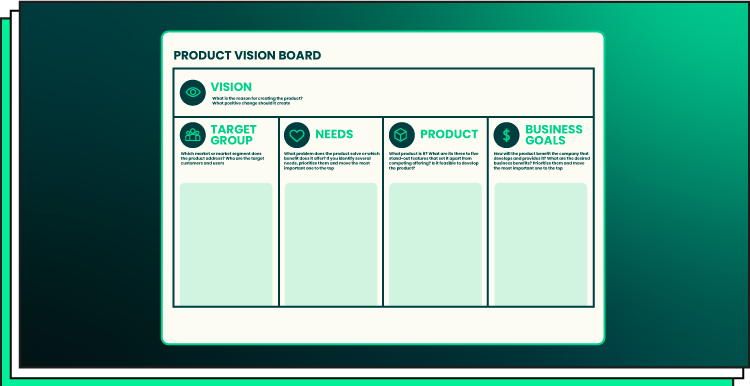In psychology, a vision board is a popular tool that helps people to gain self-awareness by representing their goals, aspirations, and dreams.
Roman Pichler, a high-profile product management expert, was the first to borrow this concept to be applied in business as a product vision canvas or board. It is meant to visualize the ways an item can benefit consumers, map out product development strategy, and align all stakeholders around a common goal.
Let’s look closer at the product’s business vision board.
The Concept of the Product Vision Template Scrutinized
The product vision board is often viewed as a graphic representation of the product strategy and development plan. Yet, these two are two distinct things. Your strategy and the plan for its implementation are prone to shift. They can change and evolve together with market fluctuations and customer needs transformation. Product vision isn’t that volatile. Ideally, once formed and described on the board, it should remain largely the same, no matter how much the strategy is modified.
The overarching purpose of the product vision board is to pitch the product vision to both external and internal stakeholders. Plus, organizations can attain some auxiliary goals by making the board a part of their product development strategy.
- Research. The product vision board is highly instrumental in the product discovery phase when companies utilize it to perform competitors and market research. In this way, they can compare their future product against analogs manufactured by rivals in the niche and clarify the business context of launching it.
- Validation. Before embarking on implementing a new idea, its authors have certain assumptions about its viability. The product vision board can help to check whether these assumptions hold water and pinpoint potential bottlenecks and risks related to the functioning of the product-to-be.
- Benchmarking. The product vision board can become a compass to steer while planning product development and, later on, a point of reference to display that you are on the right track and moving in the proper direction.
- Team alignment. The board helps to keep the team on the same page, eliminate departmental silos, and promote collaboration within the organization.
A product vision board can become a solid crutch for three basic categories of business actors.
- Startups. In their hunt for investors or partners, budding entrepreneurs can use the board as a product summary which they send to potential companions for approval or/and financial support.
- Development teams. At large enterprises, these departments can employ the board to pitch the product idea to managers, CEOs, and other decision-makers.
- Marketing teams and agencies. Charged with the task of creating a cohesive marketing and brand strategy, they can find the board helpful at the early stages of product development.
What makes the product vision board such a useful tool? Definitely, it is its structure and content.
Components of the Product Vision Board
According to Roman Pichler, the universal organization of the product vision board examples rests on five pillars.

Vision
This is what gives name to the entire model and is considered its cornerstone. In this section, you outline your mission, purpose, and ultimate objective. It should be a succinct statement that manifests the driving force behind the creation of the product you aspire to launch. Additionally, you can include here your expectations of how it will change the market, identify existing gaps in it, and explain why now is the right time to launch your product. Simply put, you tell your team what they will be working on and why it is worthwhile.
Target Group
In this field, you must list categories of people (both users and clients) who will benefit by utilizing the future product. You should mention their age, gender, educational background, location, financial status, major interests, hobbies, and values.
To increase your success chances, you should focus on a homogeneous entity within the broad market. It is better to produce a high-quality item called to cater to a limited though numerous but underserved consumer niche than market a complex multifunctional product trying to please all and sundry but ending up satisfying no one.
Needs
Here, you should outline the value proposition of your product. In other words, you must identify the pain point(s) of the target group described above and explain how your product will solve the problem. If your purpose is to deliver a product that will handle several issues, you should rank them by significance and prioritize the most crucial or lucrative business-wise. After reading this part, stakeholders should have no questions as to why customers would want to buy your product.
Product
Now we have finally reached the product itself. You should outline mission-critical characteristics of it that represent its unique selling points. It shouldn’t be an exhaustive roster mentioning everything your product can do. Instead, you should focus on up to five vital features that dovetail into the needs you enumerated above in the Needs section. Try to keep this part succinct and deliver more extensive product information in lower-level documentation (for instance, Product Backlog).
Business Goals
These aren’t about the user or the product but about your own company and the boons it will gain in the outcome. Typically, organizations aim to build their brand, expand into new markets, or boost sales. The objectives should also be ranked according to their importance, with no more than 3-5 items on the list that correlate with the content of the Vision section.
Your team can collaborate on bringing the product vision board to life by holding brainstorming sessions where visual design techniques are leveraged at large. Once properly put together, a product vision board ushers in numerous perks.
Zooming in on the Product Vision Board Benefits
As a seasoned IT vendor with multiple high-end products delivered to customers, Forbytes sees the following advantages of utilizing a product vision board.
Clear focus and direction
When all crucial product information is set out fair and square, all the team responsible for its implementation has an understanding of the aim to work for. Every crew member can refer to the board to track and assess their progress on the road to the objectives set there.
Shared awareness
With the product vision board always at their fingertips, all stakeholders are sure of their common goal and the steps to achieve it. Both managers and rank-and-file personnel across departments (development, sales, marketing, support, etc.) have a common vantage point that promotes collaboration and teamwork and rules out miscommunication and silos.
Broad stakeholder engagement
When staff members have a visual representation of the value proposition the future product will deliver, the universal buy-in among them is much higher, and the development process receives better support from everyone involved.
Fresh perspective
When you have collected all product-related data in one place, you may gain new insights that you wouldn’t get otherwise. The board may trigger modifications of certain aspects of the product or even substantial overhauling of the entire product concept. In the extreme case, you can even decide to ditch the whole idea since it turns out to be unfeasible.
Time- and cost-saving
You may follow the wrong path and waste a lot of valuable time and not less valuable resources trying to implement a product before you discover that it won’t fly. A product vision board with its capabilities for summary and insights minimizes the possibility of such an unwelcome course of events.
Iterative refinement
The board isn’t something carved in stone. As the product vision evolves, the board reflects those transformations amplifying, adjusting, and fine-tuning the concept with insights obtained from user feedback and market analytics.
Risk and opportunities identification
Favorable and dangerous situations that may occur in the process or as an outcome of product development become evident when you create the product vision board. Being aware of both, you can improve your proactive planning, mitigate potential threats, and tap new market opportunities.
Stepped up product and idea pitching
Whenever there is a need for an idea or product pitching, the vision board comes in handy, since it allows authors to express their message concisely and persuasively. And if the pitch is successful, the board provides transparency in the product management process.
All these advantages and the leveraging of product vision board promises can be maximized if you take into account the best practices for creating such a tool.
Creating a Product Vision Board: Useful Tips
We at Forbytes have profound expertise in IT product and project management, which allows us to suggest the following recommendations for the creation of an efficient and motivating product vision board.
Discover a reason for your product
You may be excited a lot about implementing some brilliant (as you think) product ideas. But it is not your eagerness that matters here. If your merchandise doesn’t change the life of consumers for the better, nobody will buy it. So, in your case, reason spells a positive change users can enjoy.
Make the needs a departure point
Some budding entrepreneurs get so carried away by the product idea that they try to find a customer need to match its feature. Instead, you should proceed the other way around and address the needs with features.
Come up with an inspiring vision
If your idea doesn’t sparkle enthusiasm in the team members, its implementation will be a tough row to hoe. Your project will crawl along at a snail’s pace while your half-hearted employees work at it with their left hand. On the contrary, if they care about what they are doing and feel they contribute to something that is worthwhile, the project will steam ahead like there is no tomorrow.
Aim high. In fact, this is a part of the inspiring vision
“Let’s win a quarter of the market in video games” sounds more down-to-earth and mundane than “We will help kids to enjoy learning while they play.” So try to set up more elevated (and inspiring) goals.
Shared vision is a must
Even if you have formulated a vivid and compelling vision, it won’t take you far unless the team believes in it. Without a common purpose behind all actions of employees, their efforts would remain haphazard and unsystematic moves that are doomed to defeat. To make it a shared asset, you should let everyone’s voice be heard and react to the feedback.
Vision must be short
Ideally, it should be a brief but powerful slogan that is easy to understand and remember. Sometimes, it takes shape over quite a long period and several iterations, but it is worth the effort. Leave the necessary but dull details to supplementary documents (product strategy, marketing plan, and business model) and give the vision a resounding form.
Turn vision into a touchstone
Since it is the main reason for creating a product, it must become a filter for change requests and new ideas expressed by the product development team. If what they suggest takes you a step closer to the vision, accept it and integrate it into the strategy and plan of action; if it doesn’t, discard it.
Balance flexibility and focus
Once created, the board never stays unchanged. It is elaborated, updated, and tweaked during product development. However, you should take care the initial vision isn’t altogether lost or altered beyond recognition to leave you with a different product compared to what you started with.
Monitor your progress
A product vision board isn’t a logical and well-contrived table meant to hang on the wall. It is a reference point where you should look back to check whether you are moving in the right direction. The best way to track the progress is to collect user feedback and assess it against your expectations.
As you see, creating a robust and motivating product vision board is a no-nonsense job that should be entrusted to competent specialists in the field. The vetted mavens of Forbytes have the expertise, skills, and requisite tech stack to deliver a product vision board that will be tailored for your use case and take into account all your requirements, industry specifics, and product aspects. Contact us to obtain a unique and efficient product vision board.
Key Takeaways
The vision board is a classical psychological tool employed to showcase a person’s dreams and inspirations. Lately, the concept has been borrowed into the realm of business, where it has transformed into a product vision board. The unity of its elements (vision, target group, needs, product, and business goals) serves an overarching purpose of pitching the product to stakeholders and representing its value proposition.
Being highly beneficial for development teams, it takes certain skills and experience to build. By hiring specialists in the field, you can enjoy all assets a workmanlike and compelling product vision board brings to its users.

Our Engineers
Can Help
Are you ready to discover all benefits of running a business in the digital era?

Our Engineers
Can Help
Are you ready to discover all benefits of running a business in the digital era?








